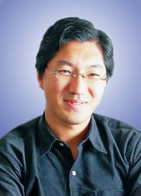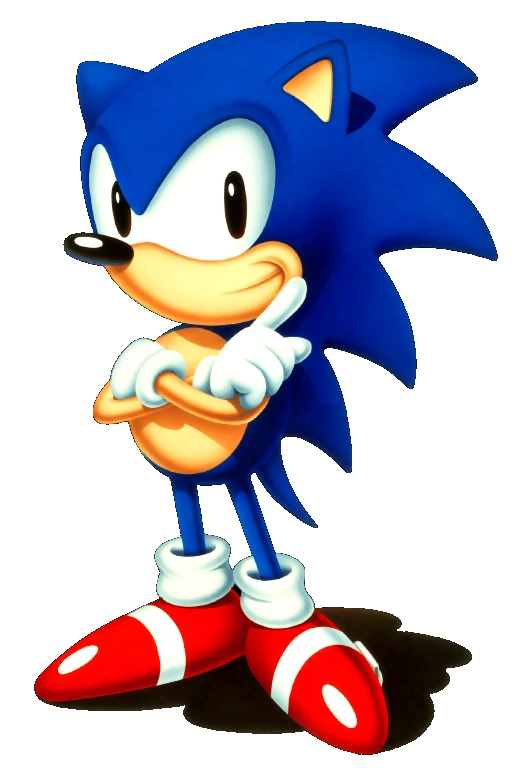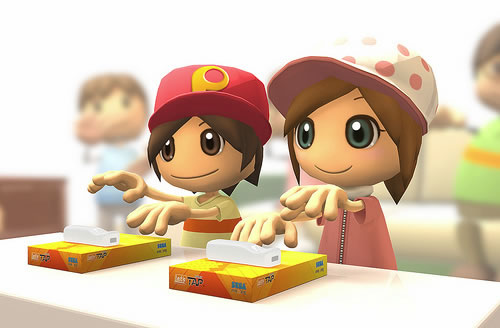Early in 1990, Sega looked to a small group of individuals to save the company’s fledgling console and give it a chance at actually taking on Nintendo. The group delivered in more ways than anyone ever though possible, and in turn created a phenomenon that shows no sign of slowing down. Sonic The Hedgehog gave Sega the edge they needed to dominate the 16-bit market and become a staple of the console wars for the next ten years. Though many people had a hand in his creation, one man brought it all together and made the new mascot into a star. That man was Yuji Naka.
 Arrogant egomaniac to some, genius to others, Naka has been synonymous with Sega for over twenty years. From his early work on such Master System gems like the original Phantasy Star to such recent efforts like Billy Hatcher & the Giant Egg on the GameCube, Naka has seen action on every Sega console and continues to be an integral part of their “platform agnostic” strategy, pushing the boundaries of innovation and originality, as well as constantly reinventing his star franchise.
Arrogant egomaniac to some, genius to others, Naka has been synonymous with Sega for over twenty years. From his early work on such Master System gems like the original Phantasy Star to such recent efforts like Billy Hatcher & the Giant Egg on the GameCube, Naka has seen action on every Sega console and continues to be an integral part of their “platform agnostic” strategy, pushing the boundaries of innovation and originality, as well as constantly reinventing his star franchise.
Born in Osaka, Japan on September 17, 1965, Naka was a bright child who kept himself entertained with the music of Riyuchi Sakamoto and his Yellow Magic Orchestra, a group which also influenced other future game developers like Kenji Eno, the creator of D & Enemy Zero). It was his love of the YMO’s synthesized melodies that eventually got him interested in computers, particularly video games. He was enthralled with the new phenomenon, as much for their technical aspects as for the immense fun he experienced playing them. He was intrigued by how they worked and wanted to dissect every one he could find, and eventually began coding his own simple games. So great was his interest that he forewent college enrollment after graduating high school in 1983 and instead dove head first into the budding home computer market. This was a risky venture, given the importance Japanese culture places on formal education.
In pursuit of a career in the gaming industry, Naka moved to Tokyo and applied for a job with Namco, who promptly overlooked him due to his lack of a college degree. It is interesting to speculate how different the gaming landscape would be today had he been hired at the house of Pac-Man! Undaunted at his rejection, Naka continued to apply at different companies until landing a job at Sega as an entry-level coder in 1984. Sega was struggling desperately against the Nintendo juggernaut at this time, and Naka relished the opportunity he had been given. He quickly made it apparent that he was no ordinary employee, and it was here that his famous attention to detail and perfectionist personality began to take form. He wanted control of every aspect of the game’s creation, from the character design to the soundtrack. Unbeknownst to him, he was exactly the type of person Sega head Hayao Nakayama was looking for.
Beginning with Girl’s Garden for the SG-1000, Naka spent the next seven years toiling away at a string of hit conversions and original titles. The impressive list of his work from this period includes such memorable games like the Master System ports of OutRun and Space Harrier, as well the legendary Phantasy Star, on which he worked with fellow Sega Star Rieko Kodama. Frequently credited during this period as “Muuuu Yuji” or “Yu2,” it was while working on Phantasy Star that Naka met the man who would eventually help him make a certain hedgehog a reality- Naoto Ohshima. In 1988, Sega realigned Consumer Department #3 into a new group called AM8, under team leader Shinobu Toyoda. Naka was lead programmer and was responsible for the Mega Drive launch port of Super Thunder Blade. His next assignment found him working once again with Kodama and Ohshima on the sequel to Phantasy Star, which made its debut a few months after the system hit shelves. There were a few other projects from this period, including the Mega Drive version of Ghouls ‘N Ghosts. In his spare time between games, Naka tinkered with ways to play NES games on the Mega Drive, an effort that eventually resulted in the first video game system emulator. Releasing such a device would have proven impossible at the time, but his efforts gained him the respect and admiration of his fellow AM8 team members, due to the complexity and innovation such an undertaking required.
While AM8 enjoyed moderate success up until this point, they finally got a chance to take the big stage in 1990, when Nakayama gave them the task of creating a new company mascot and game. Their first effort was a rabbit-like creature that could pick up objects with its ears and toss them at enemies. This proved too difficult to work into actual gameplay, and the idea was scrapped. It was during a brainstorming session with Ohshima that a feasible concept began to finally take form. Naka told Ohshima that the new hero would have to be fast, real fast. This caught his friend’s attention, and Naka proceed to reveal to him how he had long been nurturing the idea of a character that could roll itself into a ball to attack its foes.
“You’re talking about a hedgehog.” Ohshima observed.
“Yeah, you’re right.” Naka replied with a grin. With that realization, Sonic The Hedgehog was born. It would be another member of AM8 who would christen the new mascot upon observing a working build of the game a few weeks into the process. To celebrate their achievement, the team changed their name to Sonic Team.
 Upon his debut in June of 1991, Sonic took the industry by storm, selling 2.3 million Genesis units by year’s end, and sealing the fate of Nintendo’s dominance. Nakayama and the other Sega executives were elated with their new mascot’s incredible success, but Naka was less than thrilled. Dissatisfied with the company’s seniority-based pay policy, he quit Sega. He was eventually contacted by Mark Cerny, creator of Marble Madness and head of Sega’s new Technical Institute, and went to the states to work. Along with fellow SOJ recruit Hirokazu Yasuhara, the two joined the STI and worked on Sonic 2 & 3, as well as the innovative Sonic & Knuckles. By 1994, Sega was finally aware of the talent pool they had, and handed out some much-deserved promotions. Shinobu Toyoda joined management (he would eventually go on to become executive vice president), and Naka was offered the position of producer in Japan. He accepted and left the STI.
Upon his debut in June of 1991, Sonic took the industry by storm, selling 2.3 million Genesis units by year’s end, and sealing the fate of Nintendo’s dominance. Nakayama and the other Sega executives were elated with their new mascot’s incredible success, but Naka was less than thrilled. Dissatisfied with the company’s seniority-based pay policy, he quit Sega. He was eventually contacted by Mark Cerny, creator of Marble Madness and head of Sega’s new Technical Institute, and went to the states to work. Along with fellow SOJ recruit Hirokazu Yasuhara, the two joined the STI and worked on Sonic 2 & 3, as well as the innovative Sonic & Knuckles. By 1994, Sega was finally aware of the talent pool they had, and handed out some much-deserved promotions. Shinobu Toyoda joined management (he would eventually go on to become executive vice president), and Naka was offered the position of producer in Japan. He accepted and left the STI.
For the next few years, Sonic Team would churn out a solid selection of titles for the Saturn, including the much-loved NIGHTS Into Dreams, which introduced the analog pad, and the underrated Burning Rangers. Unfortunately, it would not have a hand in future Sonic games in the same way it had on the Genesis, and as a result, the franchise suffered. Developers like Traveler’s Tales did their best to recapture the magic, but games like Sonic R lacked the charm and feel of a true Sonic game. Sega of America, hard at work on Sonic Xtreme, hoped it could fill the void, but the game was a nightmare of technical and managerial problems almost from the get-go.
Perhaps its biggest blow came from Naka himself. SOA head Bernie Stolar had acquired the NIGHTS engine without Naka’s knowledge, to be used in order to save on development time. Already behind schedule, the STI needed the engine desperately, but Naka himself refused permission, and he reportedly threatened to leave the company altogether if it was used. Without the engine, the game fell even farther behind and was eventually canned.
With the release of the Dreamcast in Japan in 1998, Naka and Sonic Team continued to make quality titles. He returned to his most famous creation with the incredible Sonic Adventure, and was the first to take the console online with ChuChu Rocket. Twelve members of Sonic Team moved to San Francisco in 1999 and established an American branch, where they produced Sonic Adventure 2. It was at this time that the group suffered some heavy losses in personnel. Both Youji Ishii and Naoto Ohshima left Sonic Team to form a new company called Artoon. This decision was questionable, given that Artoon’s only products have been the mediocre Blinx games and Pinobee no Dai Bouken. Naka, on the other hand, sought to bring back the Phantasy Star series into the new age, and as all his other Dreamcast releases had done, Phantasy Star Online made great use of the built-in modem. It was released in 2000 and was the first global online console RPG. A second version was released and the game became one of the Dreamcast’s biggest hits. The series returned on the PC, GameCube, and Xbox; and set out to reach the next level with Phantasy Star Universe for the PS2, Xbox 360, and PC. An expansion called Illumines no Yabou has already been announced and should be released later this year.
The Dreamcast did not live up to its sales expectations and was eventually discontinued in 2000, forcing Sega to fold many of their development teams and integrate them into other more financially sound game houses. In April, Sonic Team officially became SONICTEAM Ltd, an annex of Sega Corp. and United Game Artists (Rez, Space Channel 5) was absorbed by Naka’s groups. When Sammy and Sega merged in 2004, Sega cleaned up their divisions and restored Sonic Team. The U.S. division was renamed Sega Studios USA, and is still headed by Takashi Iizuka.
Things haven’t been quiet for Naka in the years since the Dreamcast died. In March of 2002, he was presented with the International Game Developers Lifetime Achievement Award, for his innovative and award-winning work over the years. Such recognition only serves to inspire the man even more, enough even to strike out on his own. May of 2006 saw Naka leave Sega and Sonic Team to form his own studio, Prope. Sega itself has a 10% investment in the company, and Prope is a small slice of its “Game Creator Independence Program,” which is designed to “promote entrepreneurial business spin-offs with its internal development talent.” No announcements have yet been made, but you can be sure Naka is hard at work on his next project.
 Most of the original members of Sonic Team have left, and the quality of their releases is not at the same level as it used to be, but still the group strives on. Most recently, it released the first Sonic game for the Nintendo Wii, Sonic & the Secret Rings. As the famous hedgehog’s first foray into the current generation, this latest release has already won critical acclaim as the title to finally bring Sonic back to a semblance of the greatness he once had, with its innovative gameplay. It may not be an absolute return to form for Sonic, but there has definitely been an attempt by Sonic Team to bring Sega’s mascot back to his speedy roots, and that’s something that fans can definitely appreciate.
Most of the original members of Sonic Team have left, and the quality of their releases is not at the same level as it used to be, but still the group strives on. Most recently, it released the first Sonic game for the Nintendo Wii, Sonic & the Secret Rings. As the famous hedgehog’s first foray into the current generation, this latest release has already won critical acclaim as the title to finally bring Sonic back to a semblance of the greatness he once had, with its innovative gameplay. It may not be an absolute return to form for Sonic, but there has definitely been an attempt by Sonic Team to bring Sega’s mascot back to his speedy roots, and that’s something that fans can definitely appreciate.
As for Sonic Team, the group has released several games for all the current consoles, as well as for the new Nintendo DS, and have announced new titles in the Sonic series beyond Shadow the Hedgehog for the next generation of hardware that has arrived. Regardless of what the future may hold for Naka and Sonic Team, we can be sure that they will continue as one of Sega’s most prolific, and controversial in-house gaming studios.
Yuji Naka & Sonic Team’s complete gameography is as follows:
- Girls Garden, SG-1000 (1984)
- Great Baseball, Master System (1985)
- F-16 Fighting Falcon, Master System (1985)
- Hokuto no Ken [Black Belt], Master System (1985)
- Spy vs. Spy, Master System (1986)
- Space Harrier, Master System (1986)
- OutRun, Master System (1986)
- Phantasy Star, Master System (1987)
- Super Thunderblade, Genesis (1988)
- Phantasy Star II, Genesis (1989)
- Ghouls ‘N Ghosts, Genesis (1989)
- Sonic the Hedgehog, Genesis (1991)
- Sonic the Hedgehog 2, Genesis (1992)
- Sonic the Hedgehog 3, Genesis (1993)
- Sonic & Knuckles, Genesis (1994)
- NIGHTS Into Dreams, Saturn (1996)
- Christmas NIGHTS, Saturn (1996)
- Sonic 3D Blast [advisor], Genesis (1996)
- Sonic Jam, Saturn (1997)
- Sonic R, Saturn (1997)
- Burning Rangers, Saturn (1998)
- Sonic Adventure, Dreamcast (1998)
- Sonic the Hedgehog Pocket Adventure, Neo Geo Pocket Color (1999)
- ChuChu Rocket, Dreamcast (2000)
- Samba De Amigo, Dreamcast (2000)
- Samba De Amigo Ver. 2000, Dreamcast (2000)
- Phantasy Star Online, Dreamcast (2000)
- ChuChu Rocket, Game Boy Advance (2001)
- Phantasy Star Online Ver.2, Dreamcast (2001)
- Puyo Pop, Game Boy Advance (2001)
- Sonic Adventure 2, Dreamcast (2001)
- Minna de Puyo Puyo, Game Boy Advance (2001)
- Sonic Adventure 2 Battle, GameCube (2002)
- Phantasy Star Online, PC (2002)
- Phantasy Star Online Episodes I & II, GameCube (2002)
- Sonic Advance, Game Boy Advance (2002)
- Sonic Pinball Party, Game Boy Advance (2003)
- Sonic Battle, Game Boy Advance (2003)
- Billy Hatcher & the Giant Egg, GameCube (2003)
- Sonic Adventure DX, GameCube (2003)
- Sonic Advance 2, Game Boy Advance (2003)
- Sonic Heroes, PS2/Xbox/GameCube (2003)
- Sonic Mega Collection, GameCube (2004)
- Phantasy Star Online Plus, GameCube (2004)
- Phantasy Star Online: Blue Burst, Japanese PC (2004)
- Phantasy Star Online Ep. II: C.A.R.D. Revolution, GameCube (2004)
- Astro Boy, Playstation 2 (2004)
- Sonic Advance 3, Game Boy Advance (2004)
- Sonic Heroes, PC (2004)
- Feel the Magic XY/XX, Nintendo DS (2005)
- Phantasy Star Online: Blue Burst Episode IV, Japanese PC (2005)
- Sonic Mega Collection Plus, Xbox/PS2 (2005)
- Shadow the Hedgehog, PS2/Xbox/GameCube (2005)
- Sonic Rush, Nintendo DS (2005)
- Phantasy Star Universe, PS2/PC (2006)
- Sonic & the Secret Rings, Nintendo Wii (2007)
Sources
- Biographical Data: Yuji Naka. Sonic the Hedgehog Information Treasury. 2005.
- Champ, Louise. Developer Information- Yuji Naka. Algol Star System. 2005.
- Game Info. Multiple Titles. Green Hill Zone. 2005.
- Pettus, Sam. Genesis: A New Beginning. Eidolon’s Inn. 2001.
- Rap Sheet- Yuji Naka. Moby Games. 2005.
- Sega’s Yuji Naka to Receive IGDA’S Lifetime Achievement Award. IGDA. March 12, 2002.

Pingback: Yuji Naka – The Man Who Made The Blue Blur Fast – Tucker's Game Sphere